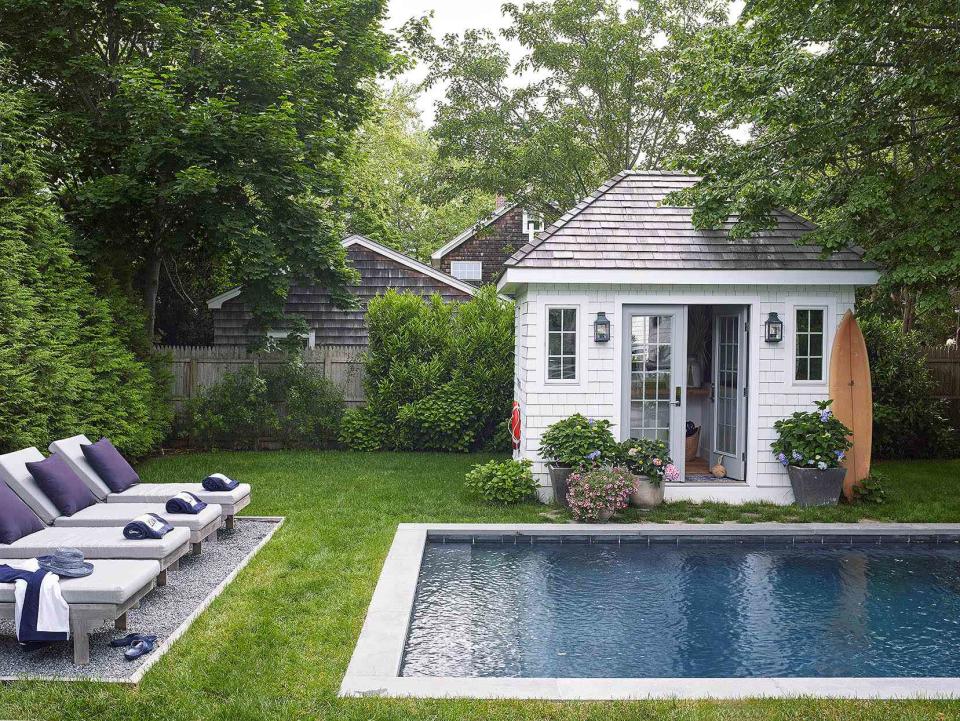How to Winterize a Pool
Keep your pool safe throughout the winter months.

Pools are a luxury home feature ideal for lounging under the sun, swimming laps to stay in shape, or simply diving in to escape the summer heat. However, when the weather starts to get colder, your in-ground pool needs to be closed in order to prevent damage to the pump and filtration system. If the pool remains open, the water circulating through the pipes will freeze and expand, resulting in costly damages, like torn seals or burst water lines.
Winter weather can also damage important equipment like the pool heater system, so it’s recommended to clean, drain, and store any equipment or accessories that can be removed from the pool. Also, you should purchase a suitable pool cover to protect the interior of the pool until warm weather returns. Use this guide to learn how to winterize a pool and prepare your equipment for the end of swimming season.
When to Start Preparing a Pool for Winter
Starting the winterizing process too late can leave your pool and pool equipment vulnerable to freezing temperatures and damage caused by ice. However, if you winterize the pool too early, the water can quickly become a playground for algae, which thrives in warmer temperatures. So before you winterize the pool, it’s a good idea to figure out exactly when you should start this process.
In general, pool owners close their pools in the fall, after the summer heat is over and before freezing temperatures pose a threat. You can tell the best time to winterize the pool when the outdoor temperatures consistently dip between 60 to 65 degrees Fahrenheit. This will reduce the chance that the pool will be taken over by algae and ensure that your pool equipment is safe for the next swimming season.
:

How to Winterize a Pool
To ensure your pool lasts for years to come, it’s essential to properly winterize it before freezing temperatures hit. If neglected, it can become a breeding ground for algae and bacteria. Follow these steps to learn how to winterize an in-ground pool.
What You Need
Water chemistry test kit
pH increaser, pH decreaser, alkalinity increaser, calcium hardness increaser, or cyanuric acid (as needed)
Pool brush
Pool vacuum
Pool skimmer
Chlorine shock treatment
Algaecide
Metal sequestrant
Screwdriver
Socket set
Wrench
Air compressor
Rubber plugs
Winter pool cover
Step 1: Test and Balance the Water
Pool chemistry refers to the balance of chemicals present in pool water. Before closing your pool, use a water chemistry test kit to ensure the water chemistry is properly balanced. If the water is not balanced, use the appropriate pool products, like a pH increaser, pH decreaser, alkalinity increaser, calcium hardness increaser, or cyanuric acid to adjust the pool chemistry.
Step 2: Scrub Pool
The next step is to deep clean the pool. Start by scrubbing the bottom and sides of the pool with a pool brush to remove any stuck-on dirt and grime. Then use a skimmer or pool net to remove any debris from the top of the water. When most of the floating debris has been removed, use a pool vacuum or an automatic pool cleaner to finish scrubbing the pool. Remember to empty out the filter and pump baskets once finished.
Step 3: Add Pool Treatment
After cleaning the pool, add a chlorine shock treatment to help get rid of any organic materials and prevent microbes from growing or reproducing in the water throughout the winter months. Algaecide should also be added to the pool water to kill any algae currently growing in the pool and to prevent future growth. Additionally, metal sequestrant may be required if your water has high levels of metal. This product suspends any metals in the water, preventing them from settling onto the pool surfaces where they can oxidize and cause lasting stains.
Step 4: Remove Pool Accessories
Prepare the pool for winter by removing the pool ladder and any accessories that could crack, warp, or otherwise break if exposed to winter weather. This generally includes handrails, fill spouts, eyeball fittings, pool cleaners, skimmer baskets, and any pool toys or recreational equipment. Store these items in a safe location like a garage or shed.
Step 5: Partially Drain Pool
The amount of water you need to drain out of the pool depends on the type of cover you use to protect it during the winter. If you have a winter pool safety cover, drain the water in the pool about six inches to one foot below the skimmer. However, if you have a solid winter pool cover, you only need to drain the water about three to four inches below the skimmer. The water level in an in-ground pool should never be lower than 18 inches below the skimmer as this can increase stress on the safety cover, causing the cover to rip or pull the anchors out of the deck.
:
Step 6: Shut Down the Pool
Turn off, unplug, and drain the water out of your electric pool heater. If you have a gas pool heater, you need to shut off the gas supply, turn off the heater, unplug the unit, and drain any pool water out of the heater. Also, turn off the power to the pump, pool lights, and any other electrical systems, like a chemical pump, salt system, or automatic pool cleaner. Ensure that any components that can be removed are safely stored in a warm, dry location during the winter months. Components that cannot be removed should be covered to protect them from snow and ice.
Step 7: Empty the Pump and Filter System
Drain water from the pump and filter system, including the chlorinator, heater, or any other pool equipment that still contains water. If you have a diatomaceous earth filter, make sure to open it up and clean the filter with a hose. Cartridge filters should also be removed, cleaned, and inspected before reinstalling the filter media. Check to ensure the filter lid and clamp band are secure before and after blowing out the water lines. Otherwise, a loose filter clamp band can cause the filter lid to blow off during startup.
:
Step 8: Blow Out the Water Lines
To prevent damage to pool water lines, remove any water before closing up the pool. This can be accomplished by blowing out the water lines with a small air compressor set to a low PSI. Start by removing all return fittings and drain plugs from the filter system, then set the multiport valve to recirculate. Set the valve in front of the pump to the skimmer line and attach the air compressor to the drain plug opening on the pump.
Don’t rush this process. Carefully blow air through the system and watch for bubbles from the return lines and skimmer. You can also use a shop vacuum to help remove the water that is being blown out of the skimmer. Once the skimmer is dry, you need to ensure that it will remain dry. Insert a rubber plug in the bottom of the skimmer and install rubber plugs in each return line as you see air bubbles escape from them.
Turn the valve in front of the pump to the main drain setting to begin moving air in that direction. Watch for air bubbles coming from the main drain in the deep end of the pool and let the air compressor run for about a minute. After a minute has passed, turn the pump valve back to the skimmer line, then turn off the air compressor. Make sure to put a plug inside the pump just in case the valve leaks.
Step 9: Cover the Pool
The last step is to cover the pool. You can use a safety cover or a solid winter cover to protect the pool during the winter months. Safety covers are designed to protect the pool from debris, while also preventing people and animals from falling in. However, it should be noted that a safety cover must be anchored down. Winter covers don’t need to be secured, but they offer less protection to the pool and any people or pets.
Tips for Using Antifreeze to Winterize a Pool
One of the methods discussed above involves blowing out the water lines so that the water cannot freeze and damage the lines during colder months. However, if you're worried about damaging the water line seals due to the high pressure required to blow out the lines, it might be a better idea to use a non-toxic pool antifreeze. This prevents the water from freezing and saves you the trouble of blowing out the lines.
The drawback to this method is that if you add the wrong type of antifreeze to your pump system it can damage the equipment. This is because salts and glycol tend to react with metals and rubbers. Additionally, antifreeze can react dangerously with chlorine, so it’s important to avoid adding the antifreeze to a chlorinator. Make sure to use non-toxic propylene glycol-based pool antifreeze, instead of an alcohol-based product.
false

